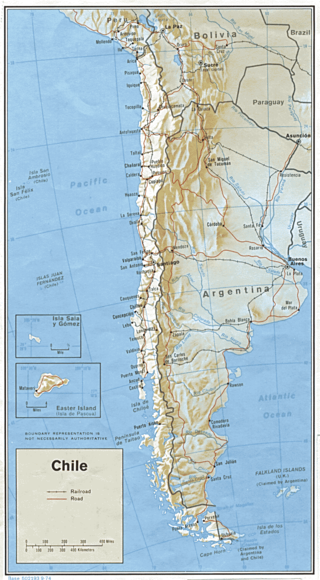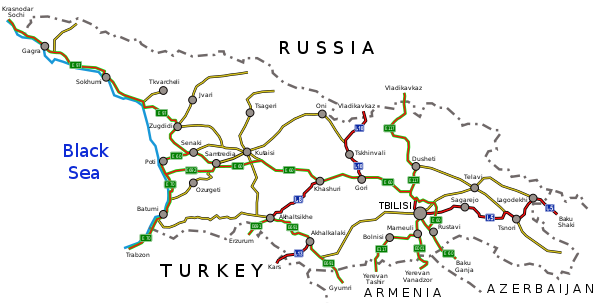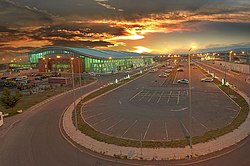This article considers transport in Armenia.

This article is about transport in Belarus.

Transport in Chile is mostly by road. The far south of the country is not directly connected to central Chile by road without travelling through Argentina, and water transport also plays a part there. The railways were historically important in Chile, but now play a relatively small part in the country's transport system. Because of the country's geography and long distances between major cities, aviation is also important.
Transportation in Ecuador is the transport infrastructure networks in Ecuador and those connecting the country with other countries. Transportation in Ecuador include aviation, highways, pipelines, ports and harbors, railways and waterways. Apart from transporting passengers, the country is a relatively small exporter of fruits and vegetables such as banana, papayas and pineapples.
Transport in Estonia relies mainly on road and rail networks.
Transportation in Guatemala includes roads, waterways, airports and a short cross-border rail line from Mexico.
Transport in Hungary relies on several main modes, including transport by road, rail, air and water.
The vast territory of Kazakhstan spans across 2,700,000 km2 (1,000,000 sq mi). The population density is low in Kazakhstan, and the centers of industry and agriculture are spread out and remote from world markets.

Transport in Kyrgyzstan is severely constrained by the country's alpine topography. Roads have to snake up steep valleys, cross passes of 3,000 m (9,843 ft) altitude and more, and are subject to frequent mud slides and snow avalanches. Winter travel is close to impossible in many of the more remote and high-altitude regions. Additional problems are because many roads and railway lines built during the Soviet period are today intersected by international boundaries, requiring time-consuming border formalities to cross where they are not completely closed. The horse is still a much used transport option, especially in rural and inaccessible areas, as it does not depend on imported fuel.
This article provides an overview of the transport infrastructure of Latvia.
Transport in Lithuania relies mainly on road and rail networks.
In 1995, the main means of transportation in Moldova were railways and a highway system. The major railway junctions are Chișinău, Bender, Ungheni, Ocnița, Bălți, and Basarabeasca. Primary external rail links connect the republic's network with Odesa on the Black Sea and with the Romanian cities of Iași and Galați; they also lead northward into Ukraine. Highways link Moldova's main cities and provide the chief means of transportation within the country, but roads are in poor repair. The country's major airport is in Chișinău.
Transport in Poland involves air, water, road and rail transportation. The country has a large network of municipal public transport, such as buses, trams and the metro. As a country located at the 'cross-roads' of Europe, Poland is a nation with a large and increasingly modern network of transport infrastructure.
This article describes the transport in Peru.

The transport network of the Russian Federation is one of the world's most extensive transport networks. The national web of roads, railways and airways stretches almost 7,700 km (4,800 mi) from Kaliningrad in the west to the Kamchatka Peninsula in the east, and major cities such as Moscow and Saint Petersburg are served by extensive rapid transit systems.

Transport in Ukraine includes ground transportation, water, air transportation, and pipelines. The transportation sector accounts for roughly 11% of the country's gross domestic product and 7% of total employment.

The transport in Azerbaijan involves air traffic, waterways and railroads. All transportation services in Azerbaijan except for oil and gas pipelines are regulated by the Ministry of Transportation of Azerbaijan Republic.

Georgian Railway LLC is the national railway company of Georgia.

Azerbaijan Railways is the national state-owned rail transport operator in the Republic of Azerbaijan. The 2,918 km (1,813 mi), 1,520 mm gauge network is electrified at 3 kV (3,000 V) DC. The headquarters of the Azerbaijan Railways is in the capital Baku.
This page is based on this
Wikipedia article Text is available under the
CC BY-SA 4.0 license; additional terms may apply.
Images, videos and audio are available under their respective licenses.


 Russia - yes - 1,520 mm (4 ft 11+27⁄32 in) - via the breakaway Autonomous Republic of Abkhazia - closed for political reasons.
Russia - yes - 1,520 mm (4 ft 11+27⁄32 in) - via the breakaway Autonomous Republic of Abkhazia - closed for political reasons. Azerbaijan - yes - 1,520 mm (4 ft 11+27⁄32 in).
Azerbaijan - yes - 1,520 mm (4 ft 11+27⁄32 in). Armenia - yes 1,520 mm (4 ft 11+27⁄32 in)
Armenia - yes 1,520 mm (4 ft 11+27⁄32 in) Turkey - yes - break-of-gauge with through 1,435 mm (4 ft 8+1⁄2 in) (Standard Gauge).
Turkey - yes - break-of-gauge with through 1,435 mm (4 ft 8+1⁄2 in) (Standard Gauge).











